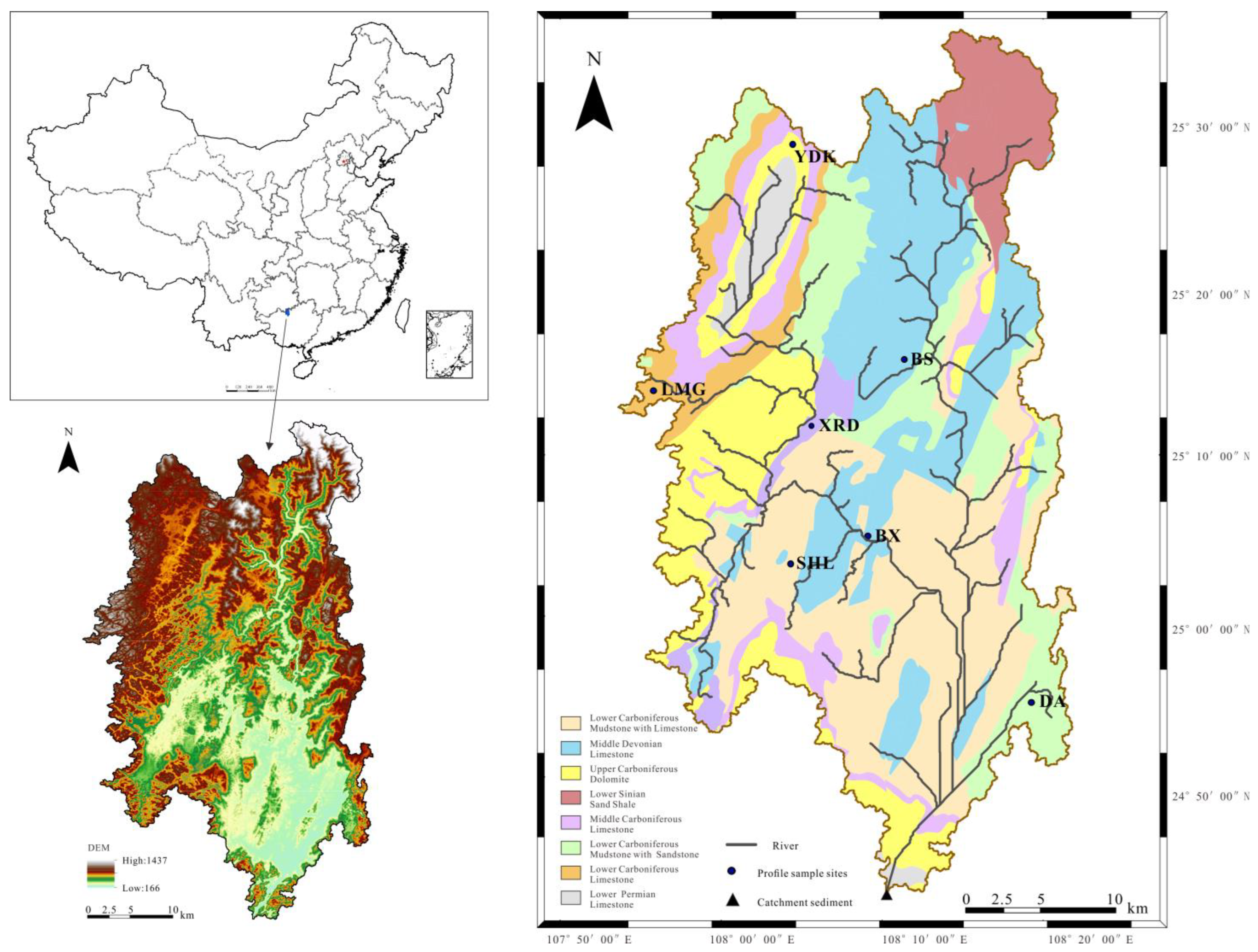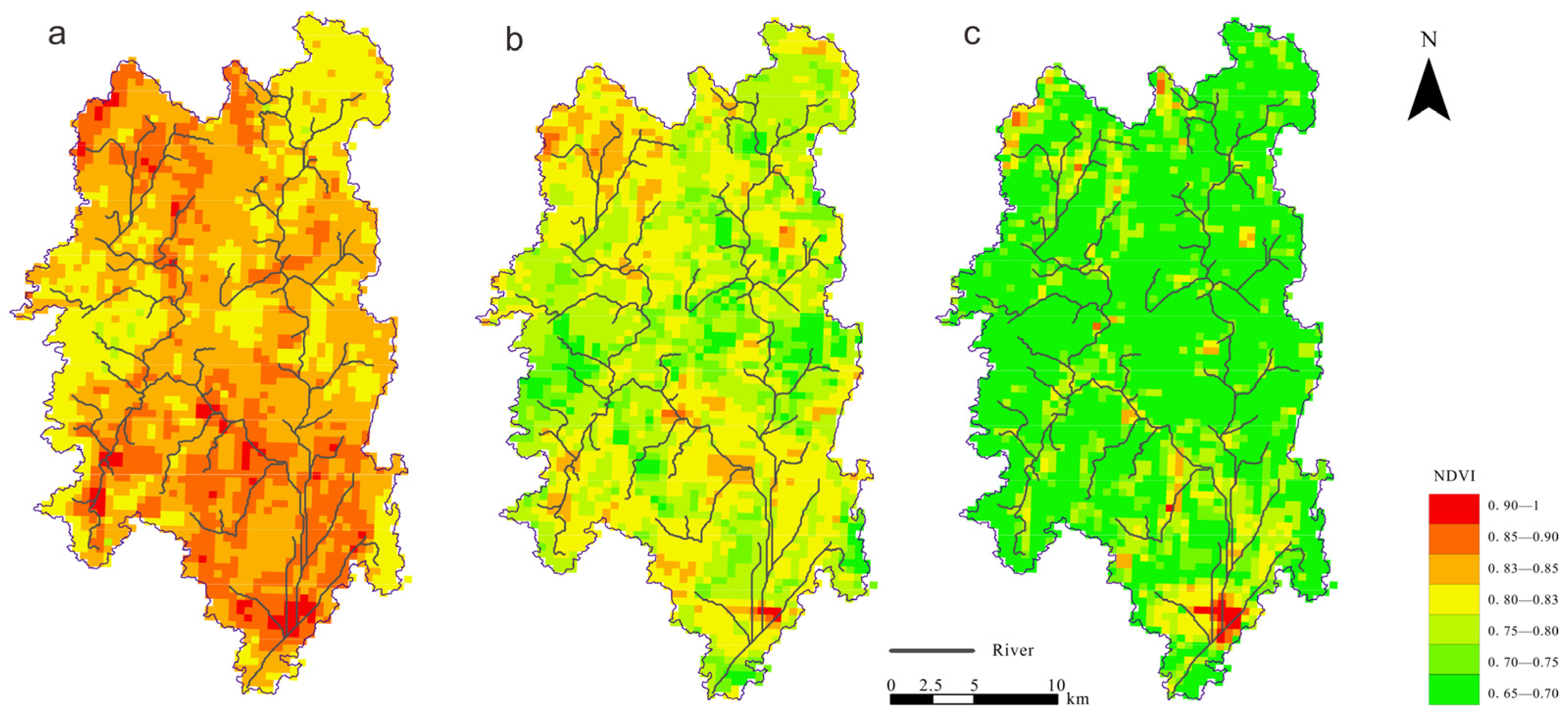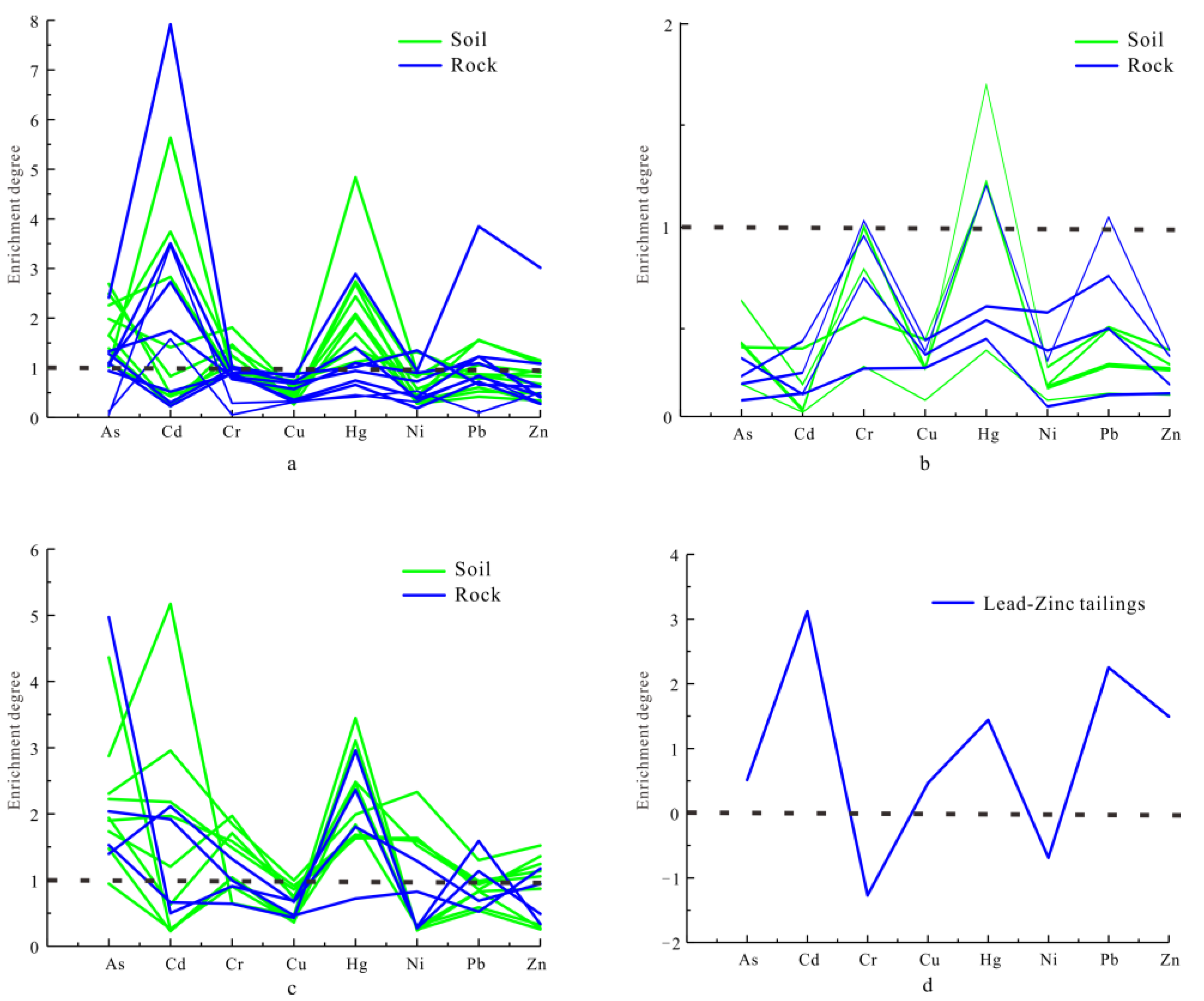Temporal Variations of Sediment Provenance in a Karst Watershed, China
Abstract
:1. Introduction
2. Methodology
2.1. Study Area
2.2. Sampling and Analysis Methods
2.2.1. Sampling
2.2.2. Laboratory Analysis
2.3. Catchment Sediment Provenance Discrimination Method
3. Results
3.1. Properties of Catchment Sediments
3.2. Properties of Profile Samples
3.3. Sediment Provenance Process
3.4. Sediment Provenance Results
4. Discussion
5. Conclusions
Author Contributions
Funding
Institutional Review Board Statement
Informed Consent Statement
Data Availability Statement
Conflicts of Interest
References
- Xiong, K.; Yin, C.; Ji, H. Soil erosion and chemical weathering in a region with typical karst topography. Environ. Earth Sci. 2018, 77, 500. [Google Scholar] [CrossRef]
- Cao, Z.; Zhang, Z.; Zhang, K.; Wei, X.; Yang, Z. Identifying and estimating soil erosion and sedimentation in small karst watersheds using a composite fingerprint technique. Agric. Ecosyst. Environ. 2020, 294, 106881. [Google Scholar] [CrossRef]
- Zcan, A.U.; Ayta, B. Effects of soil erosion on doline lake degradation within karst landscapes: Bakkal Lake, Turkey. Environ. Monit. Assess. 2020, 192, 140. [Google Scholar]
- Wen, Y.; Li, W.; Yang, Z.; Zhuo, X.; Ji, J. Evaluation of various approaches to predict cadmium bioavailability to rice grown in soils with high geochemical background in the karst region, southwestern china. Environ. Pollut. 2020, 258, 113645. [Google Scholar] [CrossRef]
- Sullivan, P.L.; Macpherson, G.L.; Martin, J.B.; Price, R.M. Evolution of carbonate and karst critical zones. Chem. Geol. 2019, 527, 119–223. [Google Scholar] [CrossRef]
- Zhang, Y.; Long, Y.; Zhang, X.; Pei, Z.; Cheng, P. Using depression deposits to reconstruct human impact on sediment yields from a small karst catchment over the past 600 years. Geoderma 2020, 363, 114168. [Google Scholar] [CrossRef]
- Hasan, O.; Miko, S.; Ilijani, N.; Brunovi, D.; Peh, Z. Discrimination of topsoil environments in a karst landscape: An outcome of a geochemical mapping campaign. Geochem. Trans. 2020, 21, 1. [Google Scholar] [CrossRef] [Green Version]
- Hao, L.B.; Tian, M.; Zhao, X.Y.; Zhao, Y.Y.; Lu, J.L.; Bai, R.J. Spatial distribution and sources of trace elements in surface soils, Changchun, China: Insights from stochastic models and geostatistical analyses. Geoderma 2016, 273, 54–63. [Google Scholar] [CrossRef]
- Zhao, L.; Hou, R. Human causes of soil loss in rural karst environments: A case study of Guizhou, China. Sci. Rep. 2019, 9, 3225. [Google Scholar] [CrossRef] [PubMed]
- Liu, C.Q. Biogeochemical Processes and Surface Material Cycle: Erosion and Biogenic Element Cycle in Southwest Karst Watershed; Science Press: Beijing, China, 2007; (In Chinese with English abstract). [Google Scholar]
- Xie, X.J.; Cheng, H.X. The suitability of floodplain sediment as a global sampling medium: Evidence from China. J. Geochem. Explor. 1997, 58, 51–62. [Google Scholar] [CrossRef]
- Xie, X.J.; Ma, X.Z.; Ren, T.X. Geochemical mapping in China. J. Geochem. Explor. 1997, 60, 99–113. [Google Scholar]
- Wang, X.Q. China geochemical baselines: Sampling methodology. J. Geochem. Explor. 2015, 148, 25–39. [Google Scholar] [CrossRef]
- Walling, D.E.; Peart, M.R.; Oldfield, F.; Thompson, R. Suspended sediment sources identified by magnetic measurements. Nature 1979, 281, 110–113. [Google Scholar] [CrossRef]
- Collins, A.L.; Pulley, S.; Foster, I.D.L.; Gellis, A.; Porto, P.; Horowitz, A.J. Sediment source fingerprinting as an aid to catchment management: A review of the current state of knowledge and a methodological decision-tree for end-users. J. Environ. Manag. 2017, 194, 86–108. [Google Scholar] [CrossRef] [PubMed] [Green Version]
- Gaspar, L.; Blake, W.H.; Smith, H.G.; Lizaga, I.; Navas, A. Testing the sensitivity of a multivariate mixing model using geochemical fingerprints with artificial mixtures. Geoderma 2019, 337, 498–510. [Google Scholar] [CrossRef]
- Tiecher, T.; Ramon, R.; Laceby, J.P.; Evrard, O.; Minella, J.P.G. Potential of phosphorus fractions to trace sediment sources in a rural catchment of southern brazil: Comparison with the conventional approach based on elemental geochemistry. Geoderma 2019, 337, 1067–1076. [Google Scholar] [CrossRef]
- Yan, T.T.; Wu, X.; Quan, Y.K.; Gong, Q.J.; Li, X.L.; Wang, P. Heredity, Inheritance and Similarity of Element Behaviors Among Parent Rocks and Their Weathered Products: A Geochemical Lithogen. Geoscience 2018, 3, 453–467, (In Chinese with English abstract). [Google Scholar]
- Gong, Q.; Deng, J.; Yang, L.; Zhang, J.; Wang, Q.; Zhang, G. Behavior of major and trace elements during weathering of sericite–quartz schist. J. Asian Earth Sci. 2011, 42, 1–13. [Google Scholar] [CrossRef]
- Tian, M.; Wang, X.; Nie, L.; Zhang, C. Recognition of geochemical anomalies based on geographically weighted regression: A case study across the boundary areas of China and Mongolia. J. Geochem. Explor. 2018, 190, 381–389. [Google Scholar] [CrossRef]
- Tian, M.; Hao, L.B.; Zhao, X.Y.; Lu, J.L.; Zhao, Y.Y. The study of stream sediment geochemical data processing by using k-means algorithm and centered logratio transformation—An example of a district in Hunan, China. Geochem. Int. 2018, 56, 1233–1244. [Google Scholar] [CrossRef]
- Gong, Q.; Liu, N.; Wu, X.; Yan, T.; Albanese, S. Using regional geochemical survey data to trace anomalous samples through geochemical genes: The tieshanlong tungsten deposit area (southeastern china) case study. J. Geochem. Explor. 2020, 219, 106637. [Google Scholar] [CrossRef]
- Gong, Q.; Yan, T.; Wu, X.; Li, R.; Wang, X.; Liu, N.; Li, X.; Wu, Y.; Li, J. Geochemical gene: A promising concept in discrimination and traceability of geological materials. Appl. Geochem. J. Int. Assoc. Geochem. Cosmochem. 2022, 136, 105133. [Google Scholar] [CrossRef]
- Pulley, S.; Collins, A.L. Tracing catchment fine sediment sources using the new sift (sediment fingerprinting tool) open source software. Sci. Total Environ. 2018, 635, 838–858. [Google Scholar] [CrossRef]
- Darnley, A.G.; Björklund, A.; Bölviken, B.; Gustavsson, N.; Koval, P.V.; Plant, J.A.; Hall, G.E.M. A Global geochemical database for environmental and resource management. Final report of IGCP Project 259. Earth Sci. 1995, 19, 122. [Google Scholar]
- Wang, X.Q.; Zhou, J.; Xu, S.F.; Chi, Q.H.; Nie, L.S.; Zhang, B.M.; Yao, W.S.; Wang, W.; Liu, H.L.; Liu, D.S.; et al. China soil geochemical baselines networks: Data characteristics. Geol. China. 2016, 43, 1469–1480. [Google Scholar]
- Lark, R.M.; Bellamy, P.H.; Rawlins, B.G. Spatio-temporal variability of some metal concentrations in the soil of eastern England, and implications for soil monitoring. Geoderma 2006, 133, 363–379. [Google Scholar] [CrossRef]
- Zhang, Q.; Bai, J.; Wang, Y. Analytical scheme and quality monitoring system for China Geochemical Baselines. Earth Sci. Front. 2012, 19, 33–42, (In Chinese with English abstract). [Google Scholar]
- Collins, A.L.; Walling, D.E.; McMellin, G.K.; Zhang, Y.; Gray, J.; McGonigle, D.; Cherrington, R. A preliminary investigation of the efficacy of riparian fencing schemes for reducing contributions from eroding channel banks to the siltation of salmonid spawning gravels across the south west UK. J. Environ. Manag. 2010, 91, 1341–1349. [Google Scholar] [CrossRef]
- Collins, A.L.; Walling, D.E.; Webb, L.; King, P. Apportioning catchment scale sediment sources using a modified composite fingerprinting technique incorporating property weightings and prior information. Geoderma 2010, 155, 249–261. [Google Scholar] [CrossRef]
- Pulley, S.; Foster, I.D.L.; Collins, A.L. The impact of catchment source group classification on the accuracy of sediment fingerprinting outputs. J. Environ. Manag. 2016, 15, 16–26. [Google Scholar] [CrossRef] [Green Version]
- Chi, Q.H. Data Manual on Applied Geochemical Element Abundance; Geological Publishing House: Beijing, China, 2007; (In Chinese with English abstract). [Google Scholar]
- Li, R.L.; Wang, S.J.; Xiong, K.N.; Li, F.Q. A study on rocky desertification evaluation index system—A case study of Guizhou Province. Trop. Geogr. 2004, 24, 145–149, (In Chinese with English abstract). [Google Scholar]
- Chen, H.; Bai, X.; Li, Y.; Luo, G.; Xi, H.; Ran, C.; Luo, X. The evolution of rocky desertification and its response to land use changes in Wanshan Karst area, Tongren City, Guizhou Province, China. J. Agric. Resour. Environ. 2020, 37, 24–35. [Google Scholar]
- Cheng, Y.S. Discussion on the Classification of Karst rocky desertification. Chin. J. Geol. Hazard Control. 2009, 20, 122–127, (In Chinese with English abstract). [Google Scholar]
- Luo, X.; Wang, S.; Bai, X.; Tan, Q.; Ran, C.; Chen, H.; Xi, H.P.; Chen, F.; Cao, Y.; Wu, L.H. Analysis on the spatio-temporal evolution process of rocky desertification in southwest karst area. Acta Ecol. Sin. 2020, 41, 680–693. [Google Scholar]
- Wei, W.; Zhou, G.; Mao, G.; Shi, Y.; Su, C. Change analysis of karst rocky desertification for almost 40 years: A case study of Guangxi, China. In Proceedings of the International Conference on Intelligent Earth Observing & Applications, Guilin, China, 23–24 October 2015. [Google Scholar]
- Chen, Y.L.; Mo, J.F.; Mo, W.H.; Zhong, S.Q.; Wang, J.H.; Ding, M.H. Temporal and Spatial Distributions of Rocky Desertification in Guangxi Karst Area in the Past 30 Years. Guangxi Sci. 2018, 25, 625–631, (In Chinese with English abstract). [Google Scholar]
- Liu, G.N.; Feng, J.L.; Li, D.W.; Cao, J.; Cui, J.Z. Formation and evolution of karst weathering crust on limestone and its cyclic significance. Carsologica Sin. 2001, 20, 183–188, (In Chinese with English abstract). [Google Scholar]
- Wang, S.J.; Sun, C.X.; Liu, X.M.; Feng, Z.G. Geochemical characteristics and formation mechanism of rock-soil interface in limestone weathering crust at Huaxi, Guizhou province. Acta Mineral. Sin. 2002, 22, 7, (In Chinese with English abstract). [Google Scholar]
- Su, J.L.; Luo, W.Q.; Wang, G.Z.; Yang, Q.Y.; Zhou, Y.H.; Huang, J. Spatiotemporal Variation of Vegetation and Its Influencing Factors in Xijiang River Basin of Guangxi Based on MODIS-EVI. Res. Soil Water Conserv. 2019, 26, 232–238, (In Chinese with English abstract). [Google Scholar]
- Zhao, K.; Zhang, L.; Dong, J.; Wu, J.; Fu, W. Risk assessment, spatial patterns and source apportionment of soil heavy metals in a typical Chinese hickory plantation region of southeastern china. Geoderma 2019, 360, 114011. [Google Scholar] [CrossRef]
- Ji, W.; Yang, Z.; Yu, T.; Yang, Q.; Wen, Y.; Wu, T. Potential ecological risk assessment of heavy metals in the Fe–Mn nodules in the karst area of Guangxi, southwest China. Bull. Env. Contam. Toxicol. 2021, 106, 51–56. [Google Scholar] [CrossRef]
- Tang, M.; Lu, G.; Fan, B.; Xiang, W.; Bao, Z. Bioaccumulation and risk assessment of heavy metals in soil-crop systems in liujiang karst area, southwestern China. Environ. Sci. Pollut. Res. 2020, 28, 9657–9669. [Google Scholar] [CrossRef] [PubMed]
- Wu, W.; Qu, S.; Nel, W.; Ji, J. The impact of natural weathering and mining on heavy metal accumulation in the karst areas of the pearl river basin, china. Sci. Total Environ. 2020, 734, 139480. [Google Scholar] [CrossRef] [PubMed]







| Analysis Method | Detection Limit | |
|---|---|---|
| As | Hydride atomic fluorescence spectrometry | 1 |
| Cd | ICP-MS | 0.02 |
| Cr | X-ray fluorescence spectrometry | 5 |
| Cu | X-ray fluorescence spectrometry | 1 |
| Hg | Cold Vapour Atomic Fluorescence Spectrometry | 0.0005 |
| Ni | ICP-MS | 2 |
| Pb | X-ray fluorescence spectrometry | 2 |
| Zn | X-ray fluorescence spectrometry | 4 |
| B | Emission spectrometry | 1 |
| Be | ICP-MS | 0.5 |
| Co | X-ray fluorescence spectrometry | 1 |
| Ga | X-ray fluorescence spectrometry | 2 |
| La | ICP-MS | 1 |
| Li | ICP-MS | 1 |
| Mo | Emission spectrometry | 0.2 |
| Nb | ICP-MS | 2 |
| Ni | ICP-MS | 2 |
| Th | X-ray fluorescence spectrometry | 2 |
| U | ICP-MS | 0.1 |
| V | X-ray fluorescence spectrometry | 5 |
| Y | X-ray fluorescence spectrometry | 1 |
| Zr | X-ray fluorescence spectrometry | 2 |
| As | Cd | Cr | Cu | Hg | Ni | Pb | Zn | |||
|---|---|---|---|---|---|---|---|---|---|---|
| Limestone | Soil | Min | 10.26 | 0.036 | 48.8 | 5.7 | 40.2 | 6.7 | 10.5 | 21.9 |
| Median | 27.17 | 0.902 | 101.5 | 16.4 | 174.0 | 31.7 | 39.0 | 75.1 | ||
| Max | 16.66 | 0.151 | 63.9 | 9.9 | 81.4 | 12.1 | 20.0 | 51.9 | ||
| CV | 33.2 | 108.8 | 26.7 | 31.3 | 46.7 | 54.3 | 45.5 | 41.6 | ||
| Rock | Min | 0.57 | 0.036 | 3.0 | 6.8 | 14.9 | 4.4 | 2.3 | 18.7 | |
| Median | 11.00 | 0.279 | 48.6 | 12.6 | 33.7 | 12.7 | 21.2 | 34.4 | ||
| Max | 24.39 | 1.267 | 57.0 | 19.3 | 104.0 | 32.4 | 96.2 | 208.0 | ||
| CV | 66.7 | 98.9 | 45.5 | 41.9 | 70.6 | 58.9 | 90.8 | 107.6 | ||
| Dolomite | Soil | Min | 4.10 | 0.011 | 31.0 | 5.5 | 36.3 | 5.0 | 7.9 | 20.5 |
| Median | 4.64 | 0.026 | 43.5 | 6.6 | 43.6 | 5.6 | 10.6 | 22.4 | ||
| Max | 6.41 | 0.064 | 55.9 | 9.8 | 61.2 | 7.4 | 12.7 | 27.2 | ||
| CV | 21.2 | 76.9 | 23.4 | 26.1 | 22.9 | 17.7 | 23.2 | 12.4 | ||
| Rock | Min | 1.46 | 0.028 | 17.0 | 6.7 | 16.1 | 2.8 | 4.4 | 12.5 | |
| Median | 2.50 | 0.037 | 47.7 | 8.3 | 20.6 | 8.8 | 15.7 | 20.3 | ||
| Max | 3.57 | 0.070 | 57.6 | 9.7 | 43.3 | 13.8 | 26.1 | 27.3 | ||
| CV | 34.9 | 45.6 | 43.0 | 14.9 | 48.9 | 53.4 | 59.9 | 35.8 | ||
| Mudstone and sand-shale | Soil | Min | 9.54 | 0.036 | 36.4 | 7.9 | 59.4 | 5.7 | 13.4 | 17.5 |
| Median | 19.57 | 0.101 | 58.2 | 10.1 | 88.3 | 7.4 | 20.8 | 59.9 | ||
| Max | 44.06 | 0.827 | 110.2 | 21.9 | 124.1 | 55.9 | 32.5 | 104.9 | ||
| CV | 50.1 | 122.9 | 39.9 | 41.8 | 27.4 | 92.7 | 30.0 | 65.1 | ||
| Rock | Min | 14.10 | 0.080 | 35.9 | 9.5 | 26.0 | 6.5 | 13.1 | 23.3 | |
| Median | 19.87 | 0.311 | 64.8 | 14.9 | 62.8 | 25.3 | 22.7 | 68.9 | ||
| Max | 50.20 | 0.349 | 88.8 | 20.1 | 106.5 | 39.3 | 39.7 | 93.7 | ||
| CV | 56.6 | 49.0 | 31.8 | 29.5 | 40.5 | 62.7 | 39.2 | 44.7 | ||
| Pb-Zn Tailings | Content | 1485 | 27.69 | 48.2 | 144.4 | 342.6 | 30.6 | 1168 | 1890.0 | |
Disclaimer/Publisher’s Note: The statements, opinions and data contained in all publications are solely those of the individual author(s) and contributor(s) and not of MDPI and/or the editor(s). MDPI and/or the editor(s) disclaim responsibility for any injury to people or property resulting from any ideas, methods, instructions or products referred to in the content. |
© 2023 by the authors. Licensee MDPI, Basel, Switzerland. This article is an open access article distributed under the terms and conditions of the Creative Commons Attribution (CC BY) license (https://creativecommons.org/licenses/by/4.0/).
Share and Cite
Tian, M.; Wang, X.; Qiao, Y.; Liu, D.; Chi, Q.; Liu, H.; Wang, W.; Zhang, B. Temporal Variations of Sediment Provenance in a Karst Watershed, China. Appl. Sci. 2023, 13, 771. https://doi.org/10.3390/app13020771
Tian M, Wang X, Qiao Y, Liu D, Chi Q, Liu H, Wang W, Zhang B. Temporal Variations of Sediment Provenance in a Karst Watershed, China. Applied Sciences. 2023; 13(2):771. https://doi.org/10.3390/app13020771
Chicago/Turabian StyleTian, Mi, Xueqiu Wang, Yu Qiao, Dongsheng Liu, Qinghua Chi, Hanliang Liu, Wei Wang, and Baoyun Zhang. 2023. "Temporal Variations of Sediment Provenance in a Karst Watershed, China" Applied Sciences 13, no. 2: 771. https://doi.org/10.3390/app13020771




